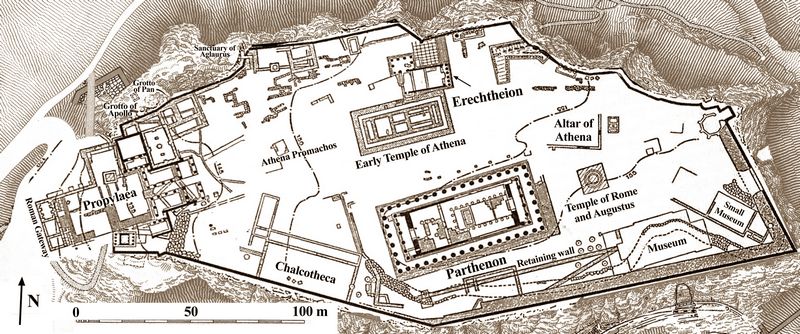|
The ancient temple of Athena on the Acropolis in Athens.
[Article originally published in 1885 in Communications of the German Imperial Archaeological Institute, Athenian Section, vol.IX, pp.275-277]
It
will be desirable to the readers of these communications to have
preliminary information on a building hitherto unknown, but which has
for a long time been the greatest temple in Athens.
It is
usually taken for granted that before the Persian wars there was a
great temple built by the Pisistratids on the site of the present
Parthenon, which was not quite finished when it was burned and
destroyed by the Persians. Its marble columns and porous entablature
are said to have been used as building material by Themistokles in the
rapid construction of the northern castle wall. Pericles erected what
is now the Parthenon on its substructure, which was not affected by the
destruction. However, several objections can be raised against this
assumption.
The column drums built into the castle wall can
hardly belong to one building with the entablature pieces located
there, because those are made of Pentelic marble, those of Peiraeus
limestone (porous); nor are those quite finished, while these were not
only fully worked out and plastered, but already painted. Furthermore,
technical features show that the substructure of an older temple lying
under the Periclean Parthenon must have been built at the same time as
the large southern wall of the castle. However, this does not fit with
the previous assumption that the older Parthenon existed long before
the Persian wars, because according to the unanimous report of the
ancient writers, the large retaining wall was first built by Kimon.
Finally, it was striking that in the long period from the (p.276)
Persian wars to Pericles the Athenians should not have thought of
rebuilding their great Athena temple. These and other questionable
points at once receive a satisfactory solution through a recent
discovery. Between the Parthenon and the Erechtheion, close to the
latter temple, there is a rectangular plateau 22 m wide and 45 m long,
in which the sacred precinct of Athena Polias was previously
recognized. However, this terrace is not entirely paved with polygonal
stones, as was believed, but consists of several strong walls, the
spaces between which are filled with earth.
In these walls we
can see the remains of a large temple, which can only be the temple of
Athena, which Herodotus often mentioned and was burned by the Persians.

Fig.1: Plan of the Acropolis, showing location of the early temple of Athena.
Even
now, before any excavations have been made, one can see that the temple
must have been a peripteros. The extant foundations and steps further
prove that it dates from the pre-Persian period, for in their
construction and material (dense limestone) they are consistent with
the remains of the older temple of Dionysus at Athens and the recently
discovered older temple at Eleusis. Furthermore, since the northern
stylobate is built over by the Korenhalle of the Erechtheion, the
temple must have already been destroyed when the present Erechtheion
was built. The old Porös entablature built into the northern castle
wall fits perfectly with the dimensions of the Lower House, if we
assume that the temple had 6 columns on each of the fronts and 12 on
each of the long sides.Some remains of the column drums from Pores came
to light during the excavations east of the Parthenon last year, and
other column drums are used as material in the lowest layers of the
same, as a detailed examination of the southern wall of the Cimons has
recently shown. The exterior of the old temple can then be fairly
completely reconstructed. The shape and dimensions (p.277) of the
cella, on the other hand, are still completely unknown, but hopefully
they will be able to be determined by excavations.
The position
of the temple in relation to the other buildings of the castle can best
be seen on the small plan of the acropolis in Michaelis-Jahn: Pausaniae
descriptio arcis Athenarum, where the place is left white and
designated by the number 39 as Athena's area. After the Persians had
destroyed all of the Pores temples, Kimon began a stately new building
further south on the site of the current Parthenon, for which he first
had to create a building site by erecting the large southern castle
wall. This new temple, which was to be even larger than the Periclean
Parthenon, was not completed, however, for Kimon's banishment and the
bad times which Athens soon had to go through interrupted the first
stages of construction. To this belong the semi-finished columnar drums
of Pentelic marble, which are visible in the northern castle wall east
of the Poros entablature. After the transfer of the federal treasury
from Delos to Athens, Pericles resumed construction and completed it in
a somewhat different form.
Before the Persian wars, there was no
temple to Athena on the site of the present Parthenon; rather, in those
times the large temple to Athena of the castle lay next to and partly
under the present Erechtheion. The old cult monuments: the holy olive
tree, the trident of Poseidon, the fountain with sea water and the tomb
of Cecrops lay directly next to the northern outer columned hall of the
old sanctuary of Athena, partly in and partly next to the old temple of
Erechtheus.
WILH. DÖRPFELD.
[Return to table of contents]
|
|